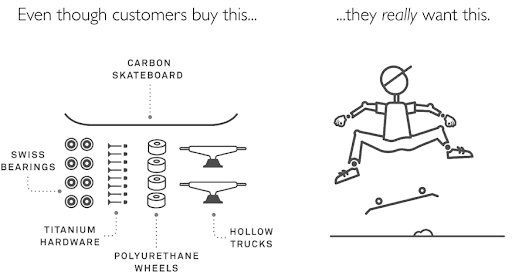When it comes to innovation, legal operations is quite a conservative field. Adopting new methods, such as customer acquisition strategy, rarely tops a company’s to-do list. However, this can significantly improve the customer experience. One of the best ways to do it is by introducing a methodological framework.
This article outlines one of the two leading approaches in product development ‘? the Jobs-To-Be-Done framework.
Table of Contents
What is the Jobs-To-Be-Done framework?
According to Clayton Christensen, the Harvard Business School professor, Jobs-To-Be-Done (JTBD) is a framework that allows us to better understand customer behavior. The idea is that people don’t essentially buy a product or service, but rather ‘rent’? it to meet their actual needs.
People don’t essentially buy your product or service, but rather ‘rent’? it to meet their actual needs.
Here’s an example. Meet Sarah, 34, married, two kids. A corporate lawyer, Sarah lives in Chicago. She is outgoing and funny; she loves barbeque and socializing. Sarah decides to buy e-signature software for work. Does she buy it because she’s 34, married, outgoing, and with two kids? Probably not. She does it because she spends 5 hours a week in traffic to meet with her clients to deliver and sign contracts. What Sarah wants is to spend more time with her kids, and that’s the real reason why she buys the e-sign software.
So, Jobs-To-Be-Done is all about your customers’ motivation and context.

The JTBD framework is native to product development, but it can be applied across multiple industries because every company has the clients that want their jobs done.
Jobs-To-Be-Done in Legal Operations
Most legal operations are usually hidden from clients but they impact customer experience. Some of the CLOC’s 12 competencies in legal departments can integrate the JTBD.
The principal goal of the legal operations is to make the legal department run like a business. This means that in terms of the JTBD framework, your company, its lawyers, and its C-level executives are the clients of your legal ops department. It’s your department that meets their needs, sells its expertise, and lets them purchase the value they lack. At the end of the day, all these are translated into company growth.
A job story formula introduced by Intercom nicely illustrates this idea:
When <situation> I want to <motivation> so I can <outcome>
JTBD is all about context. Here are some examples to give you an idea of how it works.

Legal spend management
Client: your company
Job story: When approving legal budgets, I want to see a clear picture of accruals and cost-saving opportunities, so that I could review salaries and respond to new staffing requests.
Result: With all the numbers clearly on the table, it’s easier to plan ahead. Managers can identify the weak points to factor in enough time to train the newcomers. This will significantly boost the end client’s trust.
Vendor management
Client: your company
Job story: When increasing the procurement volume, I need to make sure that the logistics are laid out on the vendor side so that I could scale the production volume without fear of supply disruptions.
Result: Vendors also need to plan their supply amounts. Mutual transparency cuts chances of any last-minute mishaps and builds your company’s reputation and client trust.
Contract management
Client: end clients and your company
Job story: When acquiring a new client, I want to make sure that contracts are delivered error-free and there’s no need to review them so that I could have more time for actual legal work.
Result: The lawyer can use the time saved to get more work done and engage more clients which naturally drives greater corporate revenue.
Knowledge management
Client: your company
Job story: When hiring a new employee, I want to make onboarding as smooth and transparent as possible, so that I could stay out of it and focus on my main tasks.
Result: Client frustration often stems from having to deal with incompetent employees. The sooner new hires perform well, the faster they meet your company’s standards bar.
Communication
Client: end customers and your company
Job story: When I review performance and leave my feedback, I want to make sure that the counterparty sees it and I don’t need to follow them up. Thus, I can plan my workflow without distractions that impact work quality.
Result: When feedback is visible for the end party by default, the workflow becomes stress- and delay-free.The lawyers can immediately proceed with their tasks, which also speeds up the process for the end client.
Basically, you need 4 things when employing JTBD:
- Figure out your competition. Is there any other way your client can achieve the same result? Can someone else do the job for you or your team? Is there any software that might disrupt the process?
This is creative destruction in action: if there is a tool that can do the same thing with little to none human involvement, it’s high time to employ it. In fact, that is how we came up with AXDRAFT in the first place. We realized that contract drafting can be done without 70% of manual work required.
- Figure out your clients’ motivation and context. What drives your clients? What do they want?
- Build your own job stories. The best way to find out what drives your clients is to interview them. For external clients, prepare a list of questions in advance. This guide might come in handy.
- Tailor the value of your services accordingly. Understanding your client’s needs is the key to providing them with the exact service they want.
Job stories can overlap for people within and outside your company, as well as across company departments and verticals. This happens because different people with different responsibilities often end up doing the same tasks.
To outline their expectations from legal operations, try to find patterns, and structure them. Armed with this knowledge, you’ll make sure that the legal team operates like a business playing its implicit and explicit roles in shaping your company’s customer experience.